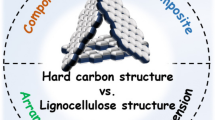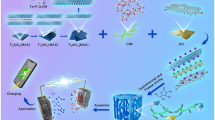Abstract
A series of carbon nanotube (CNT)-supported monometallic Pd and bimetallic Pd–Fe catalysts were synthesized and employed for catalytic hydrogenolysis of cellulose into polyols, including hexitol, ethylene glycol (EG), 1,2-propanediol (1,2-PG), and glycerol (Gly). The physicochemical properties of the catalysts were characterized by nitrogen physical adsorption measurements, X-ray diffraction analysis, transmission electron microscopy, and X-ray photoelectron spectroscopy. The total yield of hexitol, EG, 1,2-PG, and Gly in hydrolytic hydrogenation of cellulose was 37, 55, and 53% for Pd/CNTs, Pd–Fe/CNTs (Pd:Fe = 1:1), and Pd–Fe/CNTs (Pd:Fe = 1:2), respectively. Addition of Fe to Pd significantly modified the physicochemical properties of the nanoparticles and their catalytic performance, especially regarding hexitol selectivity. The promoting effect of Fe, especially for hexitol selectivity, compared with the monometallic catalyst is due to the fact that incorporation of Fe may stabilize Pd0 nanoparticles and lead to downshift of the d-band center of Pd metal nanoparticles by charge transfer from Fe to Pd. Recycling experimental results showed that leaching of Fe resulted in a significant decrease in the hexitol yield obtained using the Pd–Fe/CNTs after the first recycle, further demonstrating that Fe element plays a promoting role for hexitol formation.










Similar content being viewed by others
References
Alonso DM, Wettstein SG, Dumesic JA (2007) Bimetallic catalysts for upgrading of biomass to fuels and chemicals. Chem Soc Rev 41:8075–8098
Aronniemi A, Sainio J, Lahtinen J (2007) XPS study on the correlation between chemical state and oxygen-sensing properties of an iron oxide thin film. Appl Surf Sci 253:9476–9482
Carlsson AF, Naschitzki M, Baumer M, Freund HJ (2003) The structure and reactivity of Al2O3-supported cobalt-palladium particles: a CO-TPD, STM, and XPS study. J Phys Chem B 107:778–785
Chen H, Huang X, Zhou L-J, Li G-D, Fan M, Zou X (2016) Electrospinning synthesis of bimetallic nickel-iron oxide/carbon composite nanofibers for efficient water oxidation electrocatalysis. ChemCatChem 8:992–1000
Corma A, Iborra S, Velty A (2007) Chemical routes for the transformation of biomass into chemicals. Chem Rev 107:2411–2502
Deng T, Liu H (2014) Direct conversion of cellulose into acetol on bimetallic Ni-SnOx/Al2O3 catalysts. J Mol Chem A Chem 388:66–73
Deng W, Tan X, Fang W, Zhang Q, Wang Y (2009) Conversion of cellulose into sorbitol over carbon nanotube-supported ruthenium catalyst. Catal Lett 133:167–174
Deng W, Liu M, Tan X, Zhang Q, Wang Y (2010) Conversion of cellobiose into sorbitol in neutral water medium over carbon nanotube-supported ruthenium catalysts. J Catal 271:22–32
Fabicovicova K, Malter O, Lucas M, Claus P (2014) Hydrogenolysis of cellulose to valuable chemicals over activated carbon supported mono- and bimetallic nickel/tungsten catalysts. Green Chem 16:3580–3588
Fukuoka A, Dhepe PL (2006) Catalytic conversion of cellulose into sugar alcohols. Angew Chem Int Ed 45:5161–5163
Grilc M, Likozar B, Levec J (2014) Hydrodeoxygenation and hydrocracking of solvolysed lignocellulosic biomass by oxide, reduced and sulphide form of NiMo, Ni, Mo and Pd catalysts. Appl Catal B Environ 150:275–287
Han B, Xu C (2014) Nanoporous PdFe alloy as highly active and durable electrocatalyst for oxygen reduction reaction. Int J Hydrog Energy 39:18247–18255
Hensley AJR, Zhang R, Wang Y, McEwen J-S (2013) Tailoring the adsorption of benzene on PdFe surfaces: a density functional theory study. J Phys Chem C 117:24317–24328
Hilgert J, Meine N, Rinaldi R, Schueth F (2013) Mechanocatalytic depolymerization of cellulose combined with hydrogenolysis as a highly efficient pathway to sugar alcohols. Energy Environ Sci 6:92–96
Huber GW, Iborra S, Corma A (2006) Synthesis of transportation fuels from biomass: chemistry, catalysts, and engineering. Chem Rev 106:4044–4098
Komanoya T, Kobayashi H, Hara K, Chun W-J, Fukuoka A (2013) Simultaneous formation of sorbitol and gluconic acid from cellobiose using carbon-supported ruthenium catalysts. J Energy Chem 22:290–295
Li C, Zheng M, Wang A, Zhang T (2012) One-pot catalytic hydrocracking of raw woody biomass into chemicals over supported carbide catalysts: simultaneous conversion of cellulose, hemicellulose and lignin. Energy Environ Sci 5:6383–6390
Li C, Zhao X, Wang A, Huber GW, Zhang T (2015) Catalytic transformation of lignin for the production of chemicals and fuels. Chem Rev 115:11559–11624
Liang G, He L, Arai M, Zhao F (2014a) The Pt-enriched PtNi alloy surface and its excellent catalytic performance in hydrolytic hydrogenation of cellulose. ChemSusChem 7:1415–1421
Liang G, He L, Cheng H, Li W, Li X, Zhang C, Yu Y, Zhao F (2014b) The hydrogenation/dehydrogenation activity of supported Ni catalysts and their effect on hexitols selectivity in hydrolytic hydrogenation of cellulose. J Catal 309:468–476
Liu B, Zhang Z (2016) Catalytic conversion of biomass into chemicals and fuels over magnetic catalysts. ACS Catal 6:326–338
Liu Y, Luo C, Liu H (2012) Tungsten trioxide promoted selective conversion of cellulose into propylene glycol and ethylene glycol on a ruthenium catalyst. Angew Chem Int Ed 51:3249–3253
Liu S, Tamura M, Nakagawa Y, Tomishige K (2014) One-pot conversion of cellulose into n-hexane over the Ir-ReO x /SiO2 catalyst combined with HZSM-5. ACS Sustain Chem Eng 2:1819–1827
Liu S, Okuyama Y, Tamura M, Nakagawa Y, Imai A, Tomishige K (2015) Production of renewable hexanols from mechanocatalytically depolymerized cellulose by using Ir-ReO x /SiO2 catalyst. ChemSusChem 8:628–635
Lu Z, Hao Z, Wang J, Chen L (2016) Efficient removal of europium from aqueous solutions using attapulgite-iron oxide magnetic composites. J Ind Eng Chem 34:374–381
Niu Y, Wang H, Zhu X, Song Z, Xie X, Liu X, Han J, Ge Q (2014) Ru supported on zirconia-modified SBA-15 for selective conversion of cellobiose to hexitols. Microporous Mesoporous Mater 198:215–222
Pang J, Zheng M, Wang A, Zhang T (2011) Catalytic hydrogenation of corn stalk to ethylene glycol and 1,2-propylene glycol. Ind Eng Chem Res 50:6601–6608
Pang J, Zheng M, Sun R, Song L, Wang A, Wang X, Zhang T (2015) Catalytic conversion of cellulosic biomass to ethylene glycol: effects of inorganic impurities in biomass. Bioresour Technol 175:424–429
Sun R, Wang T, Zheng M, Deng W, Pang J, Wang A, Wang X, Zhang T (2015) Versatile nickel–lanthanum(III) catalyst for direct conversion of cellulose to glycols. ACS Catal 5:874–883
Sun R, Zheng M, Pang J, Liu X, Wang J, Pan X, Wang A, Wang X, Zhang T (2016) Selectivity-switchable conversion of cellulose to glycols over Ni-Sn catalysts. ACS Catal 6:191–201
Tai Z, Zhang J, Wang A, Pang J, Zheng M, Zhang T (2013) Catalytic conversion of cellulose to ethylene glycol over a low-cost binary catalyst of Raney Ni and tungstic acid. ChemSusChem 6:652–658
Tang W, Henkelman G (2009) Charge redistribution in core-shell nanoparticles to promote oxygen reduction. J Chem Phys 130:194504
Ungureanu A, Dragoi B, Chirieac A, Ciotonea C, Royer S, Duprez D, Mamede AS, Dumitriu E (2013) Composition-dependent morphostructural properties of Ni-Cu oxide nanoparticles confined within the channels of ordered mesoporous SBA-15 silica. ACS Appl Mater Interfaces 5:3010–3025
Vojvodic A, Norskov JK, Abild-Pedersen F (2013) Electronic structure effects in transition metal surface chemistry. Top Catal 57:25–32
Wang A, Zhang T (2013) One-pot conversion of cellulose to ethylene glycol with multifunctional tungsten-based catalysts. Acc Chem Res 46:1377–1386
Wang X, Liu X, Xu Y, Peng G, Cao Q, Mu X (2015) Sorbitol hydrogenolysis to glycerol and glycols over M-MgO (M = Ni Co, Cu) nanocomposite: a comparative study of active metals. Chin J Catal 36:1614–1622
Wettstein SG, Bond JQ, Alonso DM, Pham HN, Datye AK, Dumesic JA (2012) RuSn bimetallic catalysts for selective hydrogenation of levulinic acid to gamma-valerolactone. Appl Catal B Environ 117:321–329
Wielant J, Hauffman T, Blajiev O, Hausbrand R, Terryn H (2007) Influence of the iron oxide acid-base properties on the chemisorption of model epoxy compounds studied by XPS. J Phys Chem C 111:13177–13184
Xiao Z, Jin S, Pang M, Liang C (2013) Conversion of highly concentrated cellulose to 1,2-propanediol and ethylene glycol over highly efficient CuCr catalysts. Green Chem 15:891–895
Xu S, Yan X, Bu Q, Xia H (2016) Highly efficient conversion of carbohydrates into 5-hydroxymethylfurfural using the bi-functional CrPO4 catalyst. RSC Adv 6:8048–8052
Yang L, Yan X, Wang Q, Wang Q, Xia H (2015) One-pot catalytic conversion of cellulose into polyols with Pt/CNTs catalysts. Carbohydr Res 404:87–92
Yao Y, Patzig C, Hu Y, Scott RWJ (2015) In situ X-ray absorption spectroscopic study of Fe@FexOy/Pd and Fe@FexOy/Cu nanoparticle catalysts prepared by galvanic exchange reactions. J Phys Chem C 119:21209–21218
Yu W, Chen JG (2015) Reaction pathways of model compounds of biomass-derived oxygenates on Fe/Ni bimetallic surfaces. Surf Sci 640:159–164
Zhang Q, Jerome F (2013) Mechanocatalytic deconstruction of cellulose: an emerging entry into biorefinery. ChemSusChem 6:2042–2044
Zhang Y, Jia Y (2016) A facile precursor calcination approach to iron oxide micro/nanostructures with a high magnetization. J Alloys Compd 659:66–73
Zheng M-Y, Wang A-Q, Ji N, Pang J-F, Wang X-D, Zhang T (2011) Transition metal-tungsten bimetallic catalysts for the conversion of cellulose into ethylene glycol. ChemSusChem 3:63–66
Acknowledgments
This work was financially supported by the National Natural Science Foundation of China (grant no. 31200445) and the Natural Science Foundation of Jiangsu Province (grant nos. BK2012416 and BK20140972). This work was also financially supported by the Technology Foundation for Selected Overseas Chinese Scholar, Ministry of Personnel of China and the Priority Academic Program Development of Jiangsu Higher Education Institutions (PAPD).
Author information
Authors and Affiliations
Corresponding authors
Electronic supplementary material
Below is the link to the electronic supplementary material.
Rights and permissions
About this article
Cite this article
Xu, S., Yan, X., Bu, Q. et al. Catalytic conversion of cellulose into polyols using carbon-nanotube-supported monometallic Pd and bimetallic Pd–Fe catalysts. Cellulose 24, 2403–2413 (2017). https://doi.org/10.1007/s10570-017-1275-0
Received:
Accepted:
Published:
Issue Date:
DOI: https://doi.org/10.1007/s10570-017-1275-0




